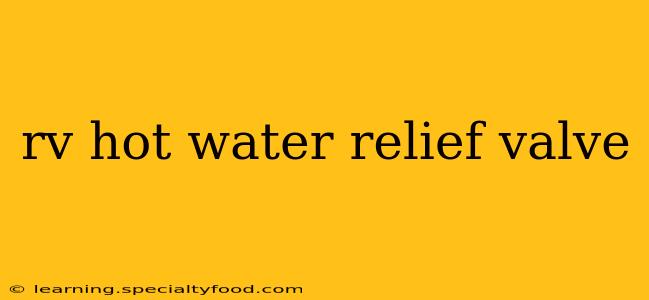Maintaining your RV's plumbing system is crucial for a safe and enjoyable camping experience. A key component of this system is the hot water relief valve, often overlooked until a problem arises. This comprehensive guide will cover everything you need to know about your RV's hot water relief valve, from its function to troubleshooting common issues.
What is an RV Hot Water Relief Valve?
Your RV's hot water relief valve is a safety device designed to prevent pressure buildup within your hot water heater tank. Water expands when heated, and if this expansion isn't managed, excessive pressure can cause the tank to rupture, leading to scalding water and significant damage. The relief valve acts as a pressure release mechanism, automatically opening when the pressure exceeds a preset limit. This releases the excess pressure and prevents a potentially dangerous situation.
How Does an RV Hot Water Relief Valve Work?
The valve is typically located on the top or side of your water heater. It contains a spring-loaded mechanism and a pressure-sensitive diaphragm. When the pressure inside the tank surpasses the valve's setting (usually around 150 PSI), the diaphragm is pushed, overcoming the spring's resistance. This allows hot water to escape through a discharge pipe, relieving the excess pressure. Once the pressure returns to a safe level, the spring pushes the diaphragm back into place, sealing the valve.
What Happens if My RV Hot Water Relief Valve Leaks?
A leaking RV hot water relief valve can indicate a few potential problems:
-
Excessive Pressure: This is the most common cause. It could be due to a faulty pressure relief valve itself, a malfunctioning pressure regulator on your water supply, or a blockage in the hot water system preventing proper expansion.
-
Temperature Issues: Extremely high water temperatures cause greater expansion, potentially leading to leaks even if the pressure is within normal parameters. Make sure your water heater is set at a safe temperature.
-
Valve Failure: The valve itself may be worn out or damaged, requiring replacement. Over time, the internal components can degrade, leading to leaks or failure to function properly.
How Often Should I Test My RV Hot Water Relief Valve?
It's recommended to test your RV hot water relief valve at least once a year, or more frequently if you notice any unusual leaks or pressure fluctuations. Testing involves manually opening the valve to ensure it operates correctly and doesn't stick. However, always ensure your hot water heater is turned off and allowed to cool completely before testing. Failure to do so could result in burns.
How to Test an RV Hot Water Relief Valve (with safety precautions!)
- Turn off the water heater. Allow it to cool completely. This step is absolutely critical for safety.
- Locate the relief valve. It's usually located on the top or side of the water heater.
- Place a container under the relief valve's discharge pipe. This will catch any water that is released.
- Manually lift the lever. There's usually a small lever or knob on the valve. If it doesn't move easily, you may need to use pliers (carefully!) Water should flow out for a few seconds, relieving pressure.
- Inspect the valve. Ensure there is no excessive corrosion or damage.
- Release the lever. The valve should seal properly after you release it.
What Causes High Water Pressure in My RV Water Heater?
High water pressure in your RV water heater is a serious concern and can damage the tank. Several factors can contribute:
-
Faulty Water Pressure Regulator: The regulator at your campsite's water source might be malfunctioning, delivering excessively high pressure to your RV's water system.
-
Closed Valves: Obstructed or closed valves can restrict water flow, increasing pressure in the system.
-
Blocked Pipes: Blockages or clogs in your plumbing can also increase the pressure in your hot water heater.
-
Overfilling the Water Heater: The water level inside the tank should not exceed the maximum fill line. Filling it too high can cause higher pressure when heated.
When Should I Replace My RV Hot Water Relief Valve?
You should replace your RV hot water relief valve if:
- It leaks constantly. A persistent leak indicates a malfunction that can't be fixed by simple maintenance.
- It fails to release pressure when tested. This renders the valve useless as a safety device.
- It shows signs of significant corrosion or damage. Deterioration can compromise its effectiveness.
Replacing the valve is a relatively simple task that can often be done by a DIY enthusiast, but if you're unsure, it's best to consult a professional RV technician. Remember to always use a replacement valve with the correct pressure rating for your water heater. Improper replacement can be a safety hazard.
This guide provides comprehensive information on your RV's hot water relief valve, helping you maintain the safety and functionality of your RV's plumbing system. Remember, regular inspection and maintenance are key to preventing costly repairs and ensuring a safe and enjoyable camping experience.
